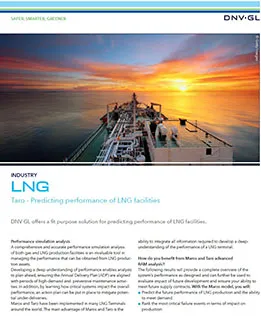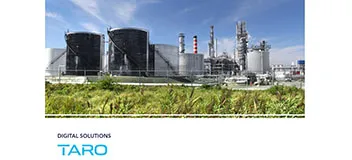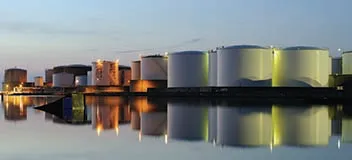DNV offers a fit purpose software solution for predicting performance of LNG facilities
Performance simulation analysis
A comprehensive and accurate performance simulation analysis of both gas and LNG production facilities is an invaluable tool in managing the performance that can be obtained from LNG production assets.
Developing a deep understanding of performance enables analysts to plan ahead, ensuring the Annual Delivery Plan (ADP) are aligned with periods of high-demand and preventive maintenance activities. In addition, by learning how critical systems impact the overall performance, an action plan can be put in place to mitigate potential under-deliveries.
Maros and Taro software have been implemented in many LNG Terminals around the world. The main advantage of Maros and Taro is the ability to integrate all information required to develop a deep-understanding of the performance of a LNG terminal.
How do you benefit from Maros and Taro advanced RAM analysis?
The following results will provide a complete overview of the system's performance as designed and can further be used to evaluate impact of future development and ensure your ability to meet future supply contracts.
With the Maros and Taro software model you will:
- Predict the future performance of LNG productions and the ability to meet demand
- Rank the most critical failure events in terms of impact on production
- Evaluate and rank the potential impact of changes on design and operational procedures
- Estimate tanker 'turnaround' times
- Evaluate weather influence on the performance of the system
- Predict annual demurrage
- Estimate frequency of top-out of storage tanks (reaching maximum level)
- Predict lost contracts
- Better understanding of the entire supply chain
- Assess the impact of shipping operations on LNG production
Modelling and optimizing product transport logistics
More specifically for the LNG industry, Maros and Taro Transport Logistics feature, covers all types of transport systems that involve movement of batches of products from suppliers to customers.
Many common transport modes are covered:
- Rail car
- Barge
- Ship
- Road tanker
Typically, products move from a supplier to a customer via loading points (berths) using a fleet of transport resources. Berths are grouped together under a parent dock. In order to completely cover the events around the transportation of products, many parameters are taken into account:
- Number of ships in fleet with loading and storage capacity
- Travel time defined per route of transport
- Probabilistic curves to account for travel delays
- Storage tank level management rules covering real operational decisions
- Weather and berthing constraints



